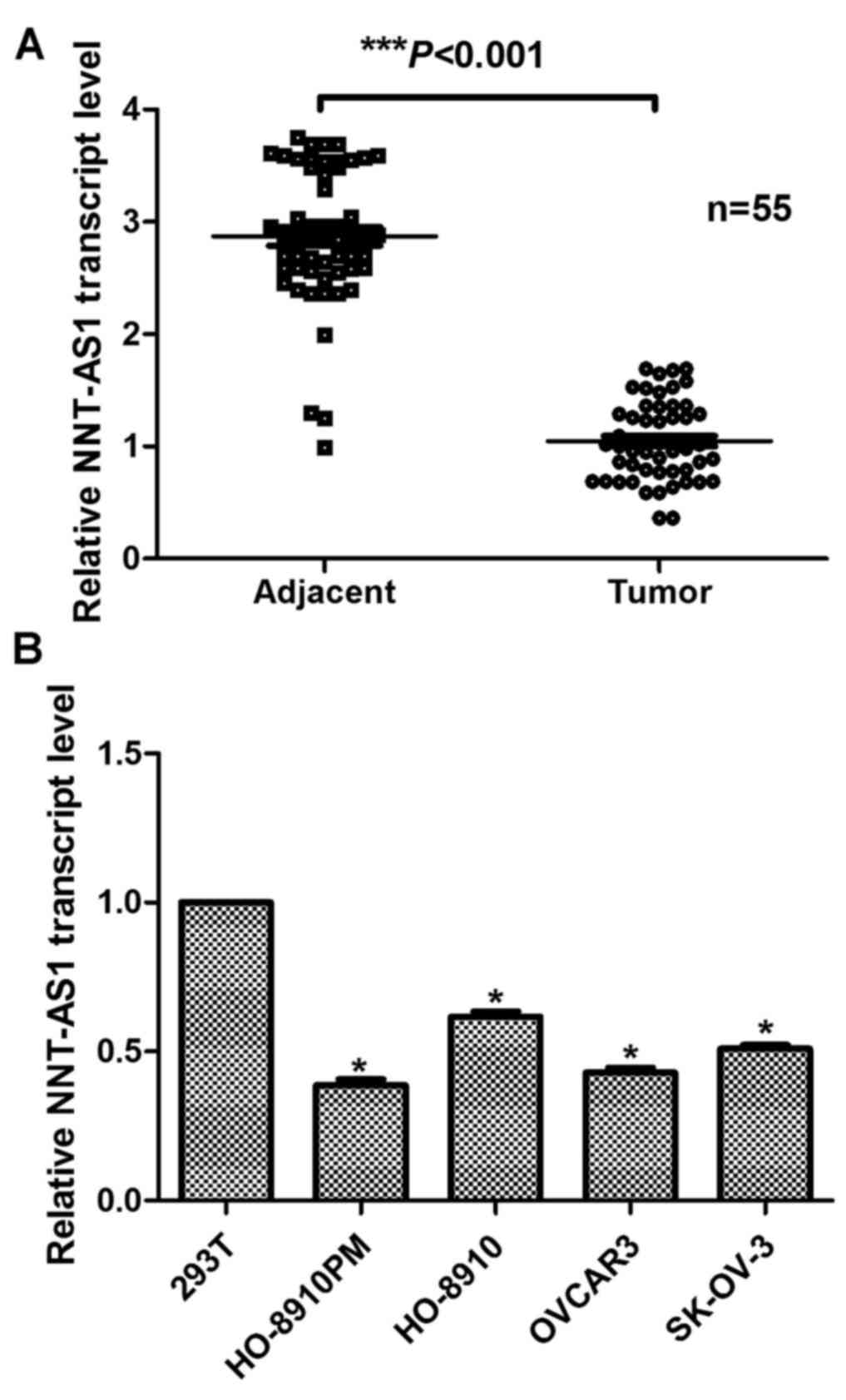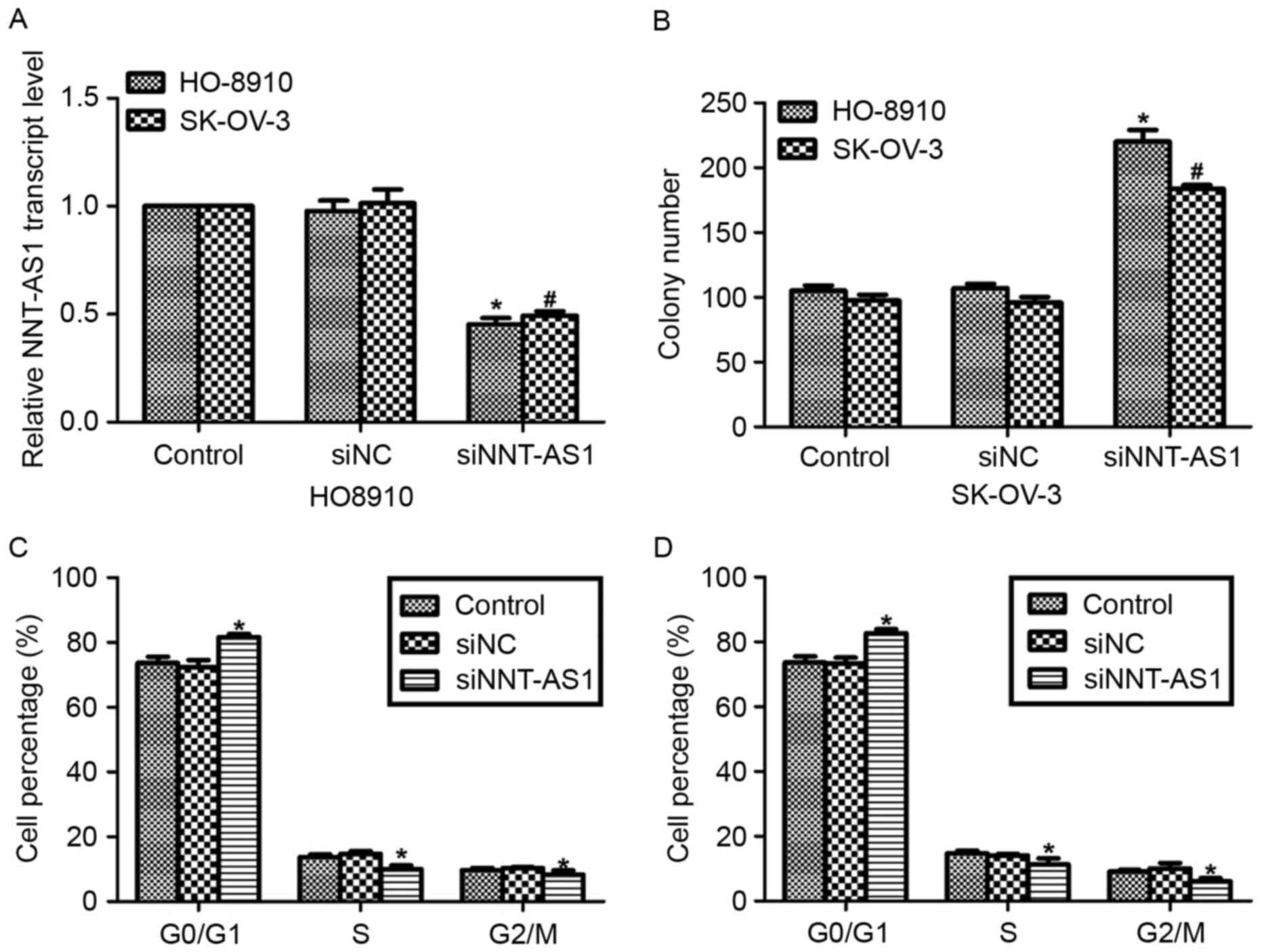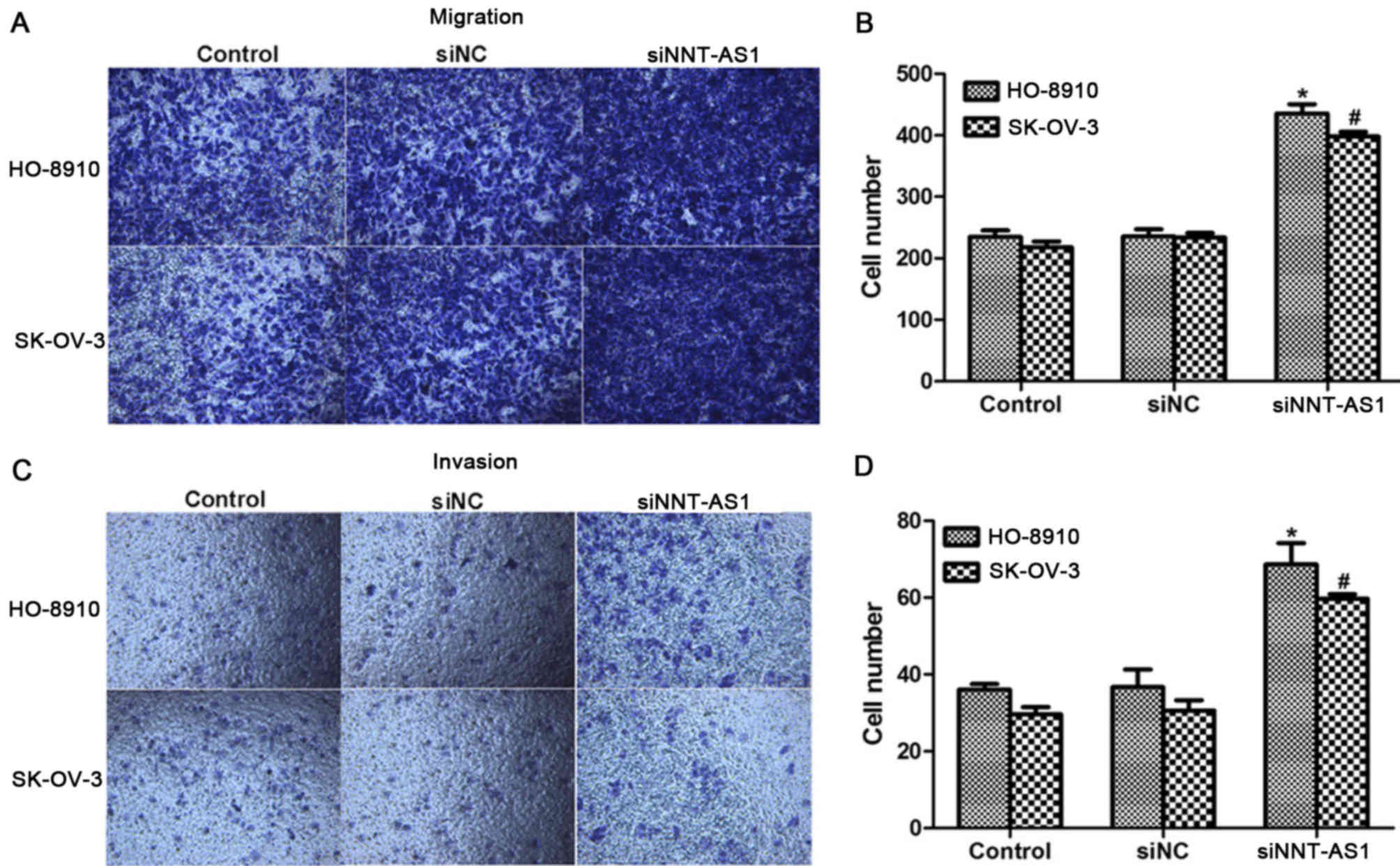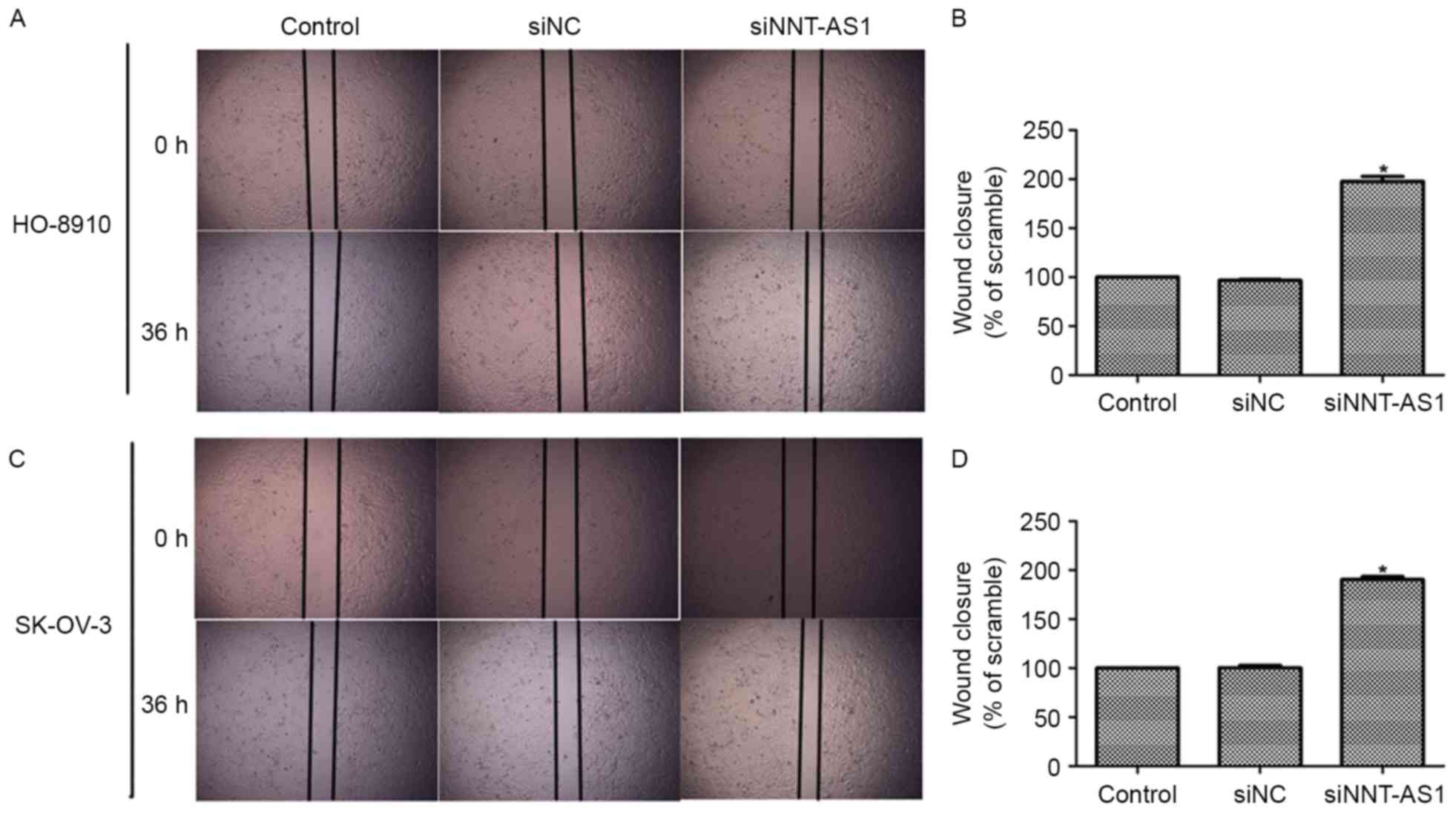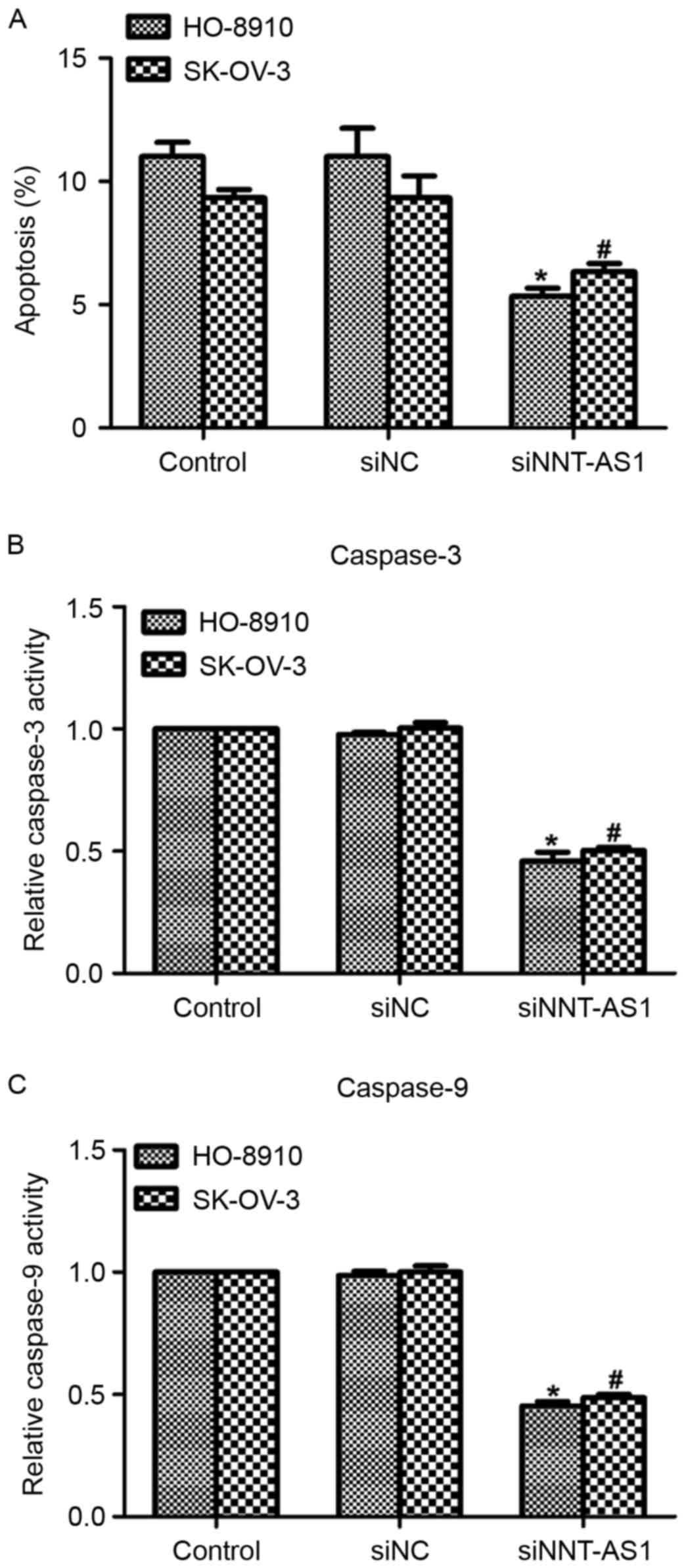Introduction
Ovarian cancer is one of the leading causes of
gynecological cancer-associated mortality in developed countries,
and often presents at an advanced stage (1). The current treatment strategy in the
majority of patients with late-stage disease involves cytoreductive
surgeries and platinum-based chemotherapy (2–4). However,
the majority of patients are resistant to chemotherapy or
radiotherapy (5,6). Therefore, it is urgent to diagnose
ovarian cancer in the early stages of the disease, and to develop
novel molecular biomarkers to measure the potential incidence rate
in females worldwide.
Although the majority of the human genome may be
transcribed into RNA, only a small fraction of RNAs has the
potential to code proteins, accounting for ~3% of the human genome
(7). The RNAs that lack these
protein-coding abilities are termed non-coding RNAs, of which long
non-coding RNAs (lncRNAs) have a length of >200 bp and they lack
an open reading frame (8). LncRNAs
are primarily transcriptionally regulated by RNA polymerase II and
serve a significant function in various process, including the
splicing of introns, 5′-end capping and 3′-end polyadenylation
(8), and have been demonstrated to
affect histone modifications, binding of transcription factors to
targeted genes and chromatin remodeling (9). LncRNAs have been indicated to affect
cancer cell proliferation (10),
metastasis (11), apoptosis (12) and autophagy (13) in a number of types of malignancy.
The lncRNA nicotinamide nucleotide
transhydrogenase-antisense RNA1 (NNT-AS1) is a newly identified
lncRNA, and has been revealed to serve a regulatory function in
human colorectal cancer (14).
NNT-AS1 is overexpressed in human colorectal cancer, and is
associated with lymph node metastasis, tumor-node-metastasis stage,
vessel invasion and differentiation (14). Knockdown of NNT-AS1 in colorectal
cancer cells suppressed tumor growth and metastasis by the
mitogen-activated protein kinase/extracellular-signal-regulated
kinase signaling pathway (14).
However, the detailed mechanisms are not known.
The present study aimed to identify the function of
NNT-AS1 in human ovarian cancer. To achieve this, specific small
interfering (si)RNA was transfected into various ovarian cancer
cells, and the effects of NNT-AS1 on cell proliferation, migration
and apoptosis were investigated using cell proliferation,
Transwell, wound-healing and cell apoptosis assays. The data
indicated a protective function of NNT-AS1 in human ovarian cancer,
providing novel insights into the diagnosis and treatment of
early-stage ovarian cancer.
Materials and methods
Human tissues
The present study was approved by the Ethic
Committee of the Third Affiliated Hospital of Soochow University
(Changzhou, China). A total of 55 patients with ovarian cancer were
included (age range, 45–75 years; median age, 58 years) between
January 2015 and January 2016, and their tumor tissues and the
adjacent non-cancerous counterparts were frozen in liquid nitrogen
once removed from the body (surgical resection) and subjected to
subsequent RNA extraction. All patients stated their full intention
to participate in the present study, and written consent from each
patient was also obtained.
Routine cell culture and
transfection
HO-8910, and SK-OV-3 human ovarian cancer cells were
purchased from the American Type Tissue Collection (Manassas, VA,
USA). All cell lines were cultured in Dulbecco's modified Eagle's
medium (DMEM; Gibco; Thermo Fisher Scientific, Inc., Waltham, MA,
USA) supplied with 10% fetal bovine serum (FBS; Gibco; Thermo
Fisher Scientific, Inc.) at 37°C in a 5% CO2 incubator.
Specific siRNAs against NNT-AS1 (GCAAGCUGACCCUGAAGUUCA) and siNC
(CUACAUCGACAAGGUGCGCGU) were designed and synthesized by Shanghai
GenePharma Co., Ltd (Shanghai, China) and the concentration of
siRNA used for transfection was 1 µM. Cell transfection was
performed using Lipofectamine® 3000 (Invitrogen; Thermo
Fisher Scientific, Inc.) for 72 h, according to the manufacturer's
protocol.
RNA extraction and quantitative
polymerase chain reaction (qPCR)
Total RNA from clinical tissues and cultured HO-8910
and SK-OV-3 cells were extracted using TRIzol® reagent
(Takara Biotechnology, Co., Ltd., Dalian, China), according to the
manufacturers' protocol. The quality and quantity of RNA were
determined using a NanoDrop 2000 instrument (NanoDrop Technologies;
Thermo Fisher Scientific, Inc.) by measuring the absorbance at 260
and 280 nm. cDNA was reverse-transcribed from 500 ng RNA using
Prime Script TM Master Mix (Takara Biotechnology, Co., Ltd.). qPCR
was then performed using SYBR Green reagent (Takara Biotechnology,
Co., Ltd.), according to the manufacturer's protocol. The
thermocycling protocol was as follows: Initial denaturation at 95°C
for 5 min, followed by 45 repeats of a three-step cycling program
consisting of 10 sec at 95°C (denaturation), 10 sec at 60°C (primer
annealing) and 10 sec at 72°C (elongation), and a final extension
step for 10 min at 72°C. The results were normalized to the
expression of GAPDH (15). The
primers used were the following: NNT-AS1, 5′-CTCCGAACCAAAAGGCGAC-3′
(forward) and 5′-CTTTGTTCTGATGGGACCC-3′ (reverse); GAPDH,
5′-CGCTCTCTGCTCCTCCTGTTC-3′ (forward) and
5′-ATCCGTTGACTCCGACCTTCAC-3′ (reverse).
Colony formation assay
The HO-8910 and SK-OV-3 cells were seeded
(1×104 cells) in 6-well plates, pre-treated with
siNNT-AS1 for 72 h at 37°C and spread onto 12-well plates (100
cells/well) in triplicate. The plates were incubated at 37°C for 14
days continuously. Subsequently, the colonies were fixed with
chilled 100% methanol and stained with crystal violet (1%) for 5
min at room temperature. Colonies that contained >50 cells were
considered to be surviving cells under a light microscope (Nikon
Corporation, Tokyo, Japan) at magnification, ×200.
Cell cycle analysis
Each group of HO-8910 and SK-OV-3 cells was seeded
into 6-well plates at a concentration of 3×105
cells/well, and pre-treated with specific siRNA against NNT-AS1
when the cell lines reached 85% confluence. Subsequently, cells
were collected following low-speed centrifugation (840 × g for 5
min) at 4°C, and the cell pellets were resuspended in 1 ml PBS,
fixed with 75% ice-cold ethanol and stored at −20°C for 2 days.
Prior to flow cytometry analysis, cells were lysed with NP-40
buffer (Beyotime Institute of Biotechnology, Haimen, China),
centrifuged (840 × g for 5 min at 4°C) and resuspended in propidium
iodide (PI; Thermo Fisher Scientific, Inc.) staining buffer
containing 50 µl/ml PI and 250 µl/ml RNase A (Beyotime Institute of
Biotechnology). Finally, the cell mixture was incubated at 4°C for
30 min in the dark, and analyzed using a fluorescence-activated
cell sorting technique on a flow cytometer (Beckman Coulter, Inc.,
Brea, CA, USA).
Transwell assay
Cell migration and invasion assays were performed in
24-well Transwell plates (8 µm pore membrane, Corning, NY, USA).
Following transfection with siRNAs, a total of 1×104
cells (HO-8910 and SK-OV-3 cells) were suspended with FBS-free DMEM
and loaded into the upper chambers, while the lower chambers were
filled with 600 µl DMEM supplemented with 10% FBS. The plates were
incubated at 37°C for an additional 24 h. Subsequently, the cells
were fixed with chilled 100% methanol for 5 min at room temperature
and stained with 0.1% crystal violet for 5 min at room temperature.
Cells on the upper surface of the chambers were removed using
cotton swabs, and images of those on the lower surface were
captured and counted using a light microscope (Nikon Corporation)
at magnification ×200 for five random fields. For the invasion
assay, the Transwell membranes were pre-incubated with
Matrigel® (Corning Incorporated, Corning, NY, USA) for 6
h at 37°C.
Wound-healing assay
Wound-healing assays were performed in HO-8910 and
SK-OV-3 cells by creating identical wounds using 10 µl sterile
pipette tips. Briefly, cells were seeded (1×104) into
6-well plates and co-incubated with siNNT-AS1 for 72 h at 37°C.
Subsequently, cells were washed with PBS twice and a cross was
scraped in the center of each well, prior to washing twice and
immediately being placed in fresh FBS-free DMEM. Images of the
cells were captured under a light microscope (Nikon Corporation) at
magnification, ×200 for each group and accounted for a time-point 0
h. Following 24 h incubation at 37°C, the two cell lines were
observed and images were captured. A total of 5 random fields of
view were selected, and the effects of NNT-AS1 were analyzed.
Cell apoptosis analysis
Flow cytometry (FACScan; BD Biosciences, Franklin
Lakes, NJ, USA) was used to determine the apoptotic rate upon
siNNT-AS1 treatment on HO-8910 and SK-OV-3 cells. Briefly, cells
(1×104) cultured in 6-well plates were harvested, washed
with PBS and collected following low-speed centrifugation (840 g
for 5 min at 4°C). Subsequently, cells were resuspended in 100 µl
staining buffer with 5 µl Annexin V-allophycocyanin (20 µg/ml) and
5 µl PI (10 mg/l) (BD Pharmingen; BD Biosciences). Cells were then
subjected to flow cytometry (excitation, 488 nm; emission, 635 nm)
and cells that were Annexin V-positive were considered to be
apoptotic. CellQuest software Pro (version 1.0, BD Biosciences) was
used to analyze the data, and each experiment was repeated at least
three times in triplicate.
Relative caspase activity
determination
The activities of caspase-3 and caspase-9 were
determined using a Caspase-3 Activity kit and a Caspase-9 Activity
kit (both from Beyotime Institute of Biotechnology), respectively,
according to the manufacturer's protocols. In brief, cell lysates
from HO-8910 and SK-OV-3 cells were collected using centrifugation
at 840 × g for 5 min at 4°C following siRNA treatment. A total of
10 µl proteins from cell lysates from each group were added into
96-well plates and mixed with 80 µl reaction buffer, which
contained caspase substrate (2 mM, Beyotime Institute of
Biotechnology). Following incubation for 4 h at 37°C, caspase
activities were determined using a microplate reader at an
absorbance of 405 nm.
Statistical analysis
All results are presented as the means ± standard
deviation. Each experiment was repeated at least three times in
triplicate, unless otherwise stated. Paired student's t-test was
performed to determine the difference between two groups. One-way
analysis of variance followed by Student-Newman-Keuls test was used
to compare the differences between multiple groups. P<0.05 was
considered to indicate a statistically significant difference, All
data were analyzed using SPSS software (version 19.0; IBM Corp.,
Armonk, NY, USA).
Results
LncRNA NNT-AS1 is downregulated in
human ovarian cancer in vivo and in vitro
The relative expression of lncRNA NNT-AS1 in samples
from 55 patients with ovarian cancer from The First People's
Hospital of Changzhou was determined. It was demonstrated that the
relative transcript level of NNT-AS1 was significantly decreased in
tumor samples compared with adjacent non-tumor samples (Fig. 1A). Subsequently, four ovarian cancer
cell lines were selected for RNA quantification of NNT-AS1. As
presented in Fig. 1B, the relative
expression of NNT-AS1 was significantly decreased in all four
ovarian cancer cell lines used, compared with the expression of
NNT-AS1 in 293T cells. Notably, HO-8910PM and OVCAR3 cells
exhibited the lowest expression levels of NNT-AS1, whereas the RNA
levels of HO-8910 and SK-OV-3 cells were slightly increased
compared with the other two cell lines. These results indicated
that the expression of NNT-AS1 was markedly decreased in human
ovarian cancer cells in vivo and in vitro.
Knockdown of NNT-AS1 in ovarian cancer
cells promotes colony formation and arrests the cell cycle at
G0/G1 phase
The effects of NNT-AS1 in human ovarian cancer were
investigated. Specific siRNAs against NNT-AS1 were transfected into
HO-8910 and SK-OV-3 cells, as these two cell lines exhibited the
highest transcript levels of NNT-AS1 of the four ovarian cancer
cell lines used. As presented in Fig.
2A, the expression levels of NNT-AS1 were significantly
decreased in HO-8910 and SK-OV-3 cells when the cells were treated
with siNNT-AS1 for 72 h. Subsequently, colony formation assays were
performed in HO-8910 and SK-OV-3 cells with or without siNNT-AS1
treatment. Following transfection of the HO-8910 cells with
siNNT-AS1, >200 colonies were counted, whereas only ~100
colonies were observed in the control cells (Fig. 2B). Furthermore, cell cycle analysis
was also performed in the HO-8910 and SK-OV-3 cells. As presented
in Fig. 2C and D, the cell cycle
distribution of siNNT-AS1 cells was altered so that the highest
proportion of cells were in the G0/G1 phase,
compared with the other cells (control and siNC) in the two cell
lines.
Knockdown of NNT-AS1 increases cell
migration and invasion in HO-8910 and SK-OV-3 cells
Cell migration are thetwo primary manifestations of
malignancies in vivo and in vitro (16). Next, the function of NNT-AS1 in cell
migration in HO-8910 and SK-OV-3 cells was investigated. As
presentedin Fig. 3A and B, cell
migratory capacities in the twocell lines were increased when
siNNT-AS1 was transfected for 72 h, as was evidentfrom the >400
cells observed to migrate through the membrane in
siNNT-AS1-stimulated cells, whereas only ~200 cells were counted on
the lower surface of the membrane. Likewise, cell invasion was also
upregulated in HO-8910 and SK-OV-3 cells when cells were treated
with siNNT-AS1 (Fig. 3C and D).
Wound-healing assays were also performed to assess
the effects of NNT-AS1 on cell migration. As presentedin Fig. 4A and B, knockdown of NNT-AS1 in
HO-8910 and SK-OV-3 cells led to increased cell migration and wound
healing compared with the control cells without transfections.
Quantification of the wound-healing assay also indicated that the
wound closure in siNNT-AS1-treated cells was almost 2-fold that of
the siNC-treated cells (Fig. 4C and
D). Together with the results presented in Fig. 3, these results suggested that NNT-AS1
inhibited cell migration in human ovarian cancer cells in
vitro.
Knockdown of NNT-AS1 inhibits cell
apoptosis in human ovarian cancer cells
Subsequently, the function of NNT-AS1 in cell
apoptosis was assessed. As presented in Fig. 5A, transfection with NNT-AS1 inhibited
cell apoptosis by 7% in HO-8910 cells and by 5% in SK-OV-3 cells.
Next, the relative activity of caspase-3 and caspase-9 was
determined in the two cell lines. It was demonstrated that the
caspase-3 activity was suppressed by >50% in HO-8910 and SK-OV-3
cells following siNNT-AS1 treatment (Fig.
5B). Furthermore, the relative caspase-9 activity was also
inhibited by NNT-AS1 knockdown in the two cell lines (Fig. 5C). These data suggested that the
downregulation of NNT-AS1 in human ovarian cancer inhibited cell
apoptosis in vitro.
Discussion
Ovarian cancer is a histologically, clinically and
molecularly diverse malignancy that occurs worldwide (17). A total of >21,980 cases of ovarian
cancer were diagnosed and 14,270 mortalities occurred in 2015 in
the USA, making it the gynecological tumor with the highest
mortality rate in developed countries (18). Therefore, an increasing number of
molecular biomarkers have become the focus of previous studies.
The present study revealed that the newlyidentified
lncRNA NNT-AS1, previously demonstrated to be overexpressed in
human colorectal cancer (19), was
downregulated in human ovarian cancer, asindicated using in
vivo and in vitro experiments. Of the fourovarian cancer
cell lines used, HO-8910PM and OVCAR3 exhibited the lowest
expression of NNT-AS1. Therefore, NNT-AS1 was overexpressed in
these two cell lines in subsequent experiments. However,
construction ofan NNT-AS1-expressing plasmid with the whole genomic
DNA failed (data not shown), and there isno known commercial source
from which to obtain this plasmid. Consequently, a second methodof
knocking down the expression of NNT-AS1 was selected, and this
demonstrated lower NNT-AS1 transcript levels in HO-8910 and SK-OV-3
cells compared with in 293T cells, and increased expression in
HO-8910 and SK-OV-3 cells compared with in HO-8910PM and OVCAR3
cells. This issue is currently being addressedas part of the
ongoing research carried out by the present authors, so that
HO-8910PM and OVCAR3 cells may be transfected with anNNT-AS1
expression plasmid. Another limitation of the present study was
that commercial normal ovarian cells were not used as the internal
control.
The results of the present study indicated
anassociation between the expression of NNT-AS1 and cell migration
(and therefore metastasis), as the lowest expression of NNT-AS1 was
demonstrated in the HO-8910PM cells, which exhibited the highest
potential for metastasis. It was also identified that knockdown of
NNT-AS1 in HO-8910 and SK-OV-3 cells promoted cell metastasis in
vitro. However, epithelial-mesenchymal transition markers were
not included in the present study. The protein level of epithelial
cadherin, neural cadherin and cyclin B1 by western blot analysis in
HO-8910 and SK-OV-3 in the presence or absence of siNNT-AS1 are
being investigated.
There have been twosignaling pathways demonstrated
to be involved in the induction of cell apoptosis: the intrinsic
and extrinsic pathways (20). The
initiation of the intrinsic pathway is associated with
pro-apoptotic factors, including B-cell lymphoma 2
(Bcl-2)-associated X protein and Bcl-2-associated death promoter,
which leads to an increased permeability of the mitochondria
membrane, loss of membrane potential and the release of cytochrome
c into the cytosol (20). The
intrinsic pathway is associated with activated caspase-3, whereas
the extrinsic pathway is associated with the activation of
caspase-8 (21). In the results of
the present study, it was indicated that the relative activities of
caspase-8 remained unchanged (data not shown), therefore it may be
that the intrinsic pathway was involved in the process, which is a
focus of future study.
Taken together, the results of the present study
suggested that the relative transcript level of NNT-AS1 was
downregulated in human ovarian cancer. HO-8910 and SK-OV-3 cells
with NNT-AS1 knocked downexhibited a greater potential to form
colonies compared with the control cells. Cell cycle was arrested
at G0/G1 phase upon siNNT-AS1 treatment in
the two cell lines. Downregulation of NNT-AS1 promoted cell
migration and invasion in HO-8910 and SK-OV-3 cells. In addition,
depletion of NNT-AS1 in human ovarian cancer cells inhibited cell
apoptosis by decreasing the relative activities of caspase-3 and
caspase-9. The results of the present study indicated the
protective function of NNT-AS1 in human ovarian cancer.
Acknowledgements
Not applicable.
Funding
No funding was received.
Availability of data and materials
The datasets used during the current study are
available from the corresponding author on reasonable request.
Authors' contributions
YH and YX constructed the experiments and organized
the data, JS assisted in the analysis of data and YX wrote the
manuscript.
Ethics approval and consent to
participate
The present study was approved by the Ethics
Committee of the Third Affiliated Hospital of Soochow University.
All patients stated their full intention to participate in the
present study, and written consent from each patient was also
obtained.
Consent for publication
All patients provided permission to participate in
the present study, and written consent was obtained from each
patient.
Competing interests
The authors declare that they have no competing
interests.
References
|
1
|
Ferlay J, Steliarova-Foucher E,
Lortet-Tieulent J, Rosso S, Coebergh JW, Comber H, Forman D and
Bray F: Cancer incidence and mortality patterns in Europe:
Estimates for 40 countries in 2012. Eur J Cancer. 49:1374–1403.
2013. View Article : Google Scholar : PubMed/NCBI
|
|
2
|
Vergote I, Oaknin A, Baurain JF, Ananda S,
Wong S, Su X, Wu B, Zhong Z, Warner D and Casado A: A phase 1b,
open-label study of trebananib in combination with paclitaxel and
carboplatin in patients with ovarian cancer receiving interval or
primary debulking surgery. Eur J Cancer. 50:2408–2416. 2014.
View Article : Google Scholar : PubMed/NCBI
|
|
3
|
Vergote I, Amant F, Kristensen G, Ehlen T,
Reed NS and Casado A: Primary surgery or neoadjuvant chemotherapy
followed by interval debulking surgery in advanced ovarian cancer.
Eur J Cancer. 47 Suppl 3:S88–S92. 2011. View Article : Google Scholar : PubMed/NCBI
|
|
4
|
Reed NS, Mangioni C, Malmström H, Scarfone
G, Poveda A, Pecorelli S, Tateo S, Franchi M, Jobsen JJ, Coens C,
et al: Phase III randomised study to evaluate the role of adjuvant
pelvic radiotherapy in the treatment of uterine sarcomas stages I
and II: An European Organisation for Research and Treatment of
Cancer Gynaecological Cancer Group Study (protocol 55874). Eur J
Cancer. 44:808–818. 2008. View Article : Google Scholar : PubMed/NCBI
|
|
5
|
Pinsky PF, Yu K, Kramer BS, Black A, Buys
SS, Partridge E, Gohagan J, Berg CD and Prorok PC: Extended
mortality results for ovarian cancer screening in the PLCO trial
with median 15 years follow-up. Gynecol Oncol. 143:270–275. 2016.
View Article : Google Scholar : PubMed/NCBI
|
|
6
|
Jacobs IJ, Menon U, Ryan A, Gentry-Maharaj
A, Burnell M, Kalsi JK, Amso NN, Apostolidou S, Benjamin E,
Cruickshank D, et al: Ovarian cancer screening and mortality in the
UK collaborative trial of ovarian cancer screening (UKCTOCS): A
randomised controlled trial. Lancet. 387:945–956. 2016. View Article : Google Scholar : PubMed/NCBI
|
|
7
|
Djebali S, Davis CA, Merkel A, Dobin A,
Lassmann T, Mortazavi A, Tanzer A, Lagarde J, Lin W, Schlesinger F,
et al: Landscape of transcription in human cells. Nature.
489:101–108. 2012. View Article : Google Scholar : PubMed/NCBI
|
|
8
|
Derrien T, Johnson R, Bussotti G, Tanzer
A, Djebali S, Tilgner H, Guernec G, Martin D, Merkel A, Knowles DG,
et al: The GENCODE v7 catalog of human long noncoding RNAs:
Analysis of their gene structure, evolution, and expression. Genome
Res. 22:1775–1789. 2012. View Article : Google Scholar : PubMed/NCBI
|
|
9
|
Melissari MT and Grote P: Roles for long
non-coding RNAs in physiology and disease. Pflugers Arch.
468:945–958. 2016. View Article : Google Scholar : PubMed/NCBI
|
|
10
|
Lin CY, Kleinbrink EL, Dachet F, Cai J, Ju
D, Goldstone A, Wood EJ, Liu K, Jia H, Goustin AS, et al:
Primate-specific oestrogen-responsive long non-coding RNAs regulate
proliferation and viability of human breast cancer cells. Open
Biol. 6:1502622016. View Article : Google Scholar : PubMed/NCBI
|
|
11
|
Wang X, Sehgal L, Jain N, Khashab T,
Mathur R and Samaniego F: LncRNA MALAT1 promotes development of
mantle cell lymphoma by associating with EZH2. J Transl Med.
14:3462016. View Article : Google Scholar : PubMed/NCBI
|
|
12
|
Wei S and Wang K: Long noncoding RNAs:
Pivotal regulators in acute myeloid leukemia. Exp Hematol Oncol.
5:302016. View Article : Google Scholar : PubMed/NCBI
|
|
13
|
Zhuo C, Jiang R, Lin X and Shao M: LncRNA
H19 inhibits autophagy by epigenetically silencing of DIRAS3 in
diabetic cardiomyopathy. Oncotarget. 8:1429–1437. 2017. View Article : Google Scholar : PubMed/NCBI
|
|
14
|
Wang Q, Yang L, Hu X, Jiang Y, Hu Y, Liu
Z, Liu J, Wen T, Ma Y, An G and Feng G: Upregulated NNT-AS1, a long
noncoding RNA, contributes to proliferation and migration of
colorectal cancer cells in vitro and in vivo. Oncotarget.
8:3441–3453. 2017.PubMed/NCBI
|
|
15
|
Livak KJ and Schmittgen TD: Analysis of
relative gene expression data using real-time quantitative PCR and
the 2(-Delta Delta CT)) method. Methods. 25:402–408. 2001.
View Article : Google Scholar : PubMed/NCBI
|
|
16
|
Chaffer CL and Weinberg RA: A perspective
on cancer cell metastasis. Science. 331:1559–1564. 2011. View Article : Google Scholar : PubMed/NCBI
|
|
17
|
Yeung TL, Leung CS, Li F, Wong SS and Mok
SC: Targeting stromal-cancer cell crosstalk networks in ovarian
cancer treatment. Biomolecules. 6:32016. View Article : Google Scholar : PubMed/NCBI
|
|
18
|
Siegel RL, Miller KD and Jemal A: Cancer
statistics, 2015. CA Cancer J Clin. 65:5–29. 2015. View Article : Google Scholar : PubMed/NCBI
|
|
19
|
Liu T, Zhang X, Gao S, Jing F, Yang Y, Du
L, Zheng G, Li P, Li C and Wang C: Exosomal long noncoding RNA
CRNDE-h as a novel serum-based biomarker for diagnosis and
prognosis of colorectal cancer. Oncotarget. 7:85551–85563. 2016.
View Article : Google Scholar : PubMed/NCBI
|
|
20
|
Spencer SL and Sorger PK: Measuring and
modeling apoptosis in single cells. Cell. 144:926–939. 2011.
View Article : Google Scholar : PubMed/NCBI
|
|
21
|
Du Y, Gong J, Tian X, Yan X, Guo T, Huang
M, Zhang B, Hu X, Liu H, Wang Y, et al: Japonicone A inhibits the
growth of non-small cell lung cancer cells via
mitochondria-mediated pathways. Tumour Biol. 36:7473–7482. 2015.
View Article : Google Scholar : PubMed/NCBI
|















